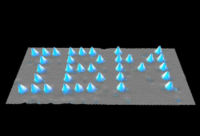Nanotechnology
(As interesting and capable as advanced nanotechnology is likely to be, it is not actually a requirement for the development of an advanced post-scarcity society, which can be achieved with today's technology. Having said that, nanotech-based decentralized fabrication, more than any other technology, will make post-scarcity not merely possible, but easy. Anyway, the social changeover to an advanced post-scarcity society will not happen overnight, we must take into account the technologies that will be developed in the intervening years.)
The advanced automation section has mainly focused on automation technologies using robotics and 'macro'-scale systems, as it describes systems that could be achieved with today's technology. However, even more sophisticated and capable technology using nano-scale devices  (at the atomic and molecular scale) are likely to be feasible in the coming decades, that could ultimately give us a similar level of control over matter that we currently have over information using computers. See also related Diamond Mechanosynthesis.
(at the atomic and molecular scale) are likely to be feasible in the coming decades, that could ultimately give us a similar level of control over matter that we currently have over information using computers. See also related Diamond Mechanosynthesis.
This is likely to end up being a mixture of top-down engineering techniques related to current semi-conductor fabrication  and micro-electro-mechanical systems
and micro-electro-mechanical systems  (MEMS), true bottom-up molecular engineering and self-assembly, and derivatives from biotechnology
(MEMS), true bottom-up molecular engineering and self-assembly, and derivatives from biotechnology  . This is likely to give us systems of unprecedented precision, capability and small size that will further revolutionise manufacturing, power generation, agriculture and medicine.
. This is likely to give us systems of unprecedented precision, capability and small size that will further revolutionise manufacturing, power generation, agriculture and medicine.
Nano-scale devices that could be sent inside the human body as a medical intervention are being developed. Mice have already been cured of type-I diabetes with this method[1].
The SXM Project is an open-source hardware project bringing nanotechnology research tools to the people. The SXM Project now has a complete, functioning design for one of the two basic tools of nanotechnology: the scanning tunneling microscope, which can scan and manipulate single atoms. The open-source version costs less than €1000, compared to about €11,000 for commercial versions. An open-source atmomic force microscope - an evolution of the scanning tunneling microscope - is in the test phase.
Current nanotechnology such as this is limited to simple designs on the nanometer scale (a nanometer is a billionth of a meter). We currently have instruments that allow atomically-precise engineering like this —
This is a picture taken by a scanning tunnelling microscope in 1990. It shows the IBM logo constructed from 35 xenon atoms on a nickel surface. The aim is to increase the complexity of atomically-precise manufacturing until we can make things like this —
This is a computer-simulated design of a gear, built out of atoms, that could be used to power a nanorobot. As technology progresses in the next two or three decades, we expect to see more and more sophisticated atomically-precise engineering, marking the move from 'nanoparticles' to 'nanorobots'. These tiny robots could be equipped with onboard computers, sensors and artificial intelligence systems and could be controlled by external acoustic signals. They would be about 100 nanometers in diameter (meaning a trillion could be packed into one cubic millimeter). The applications of this technology would be as broad as the applications of computers; few areas of life will be unaffected if and when atomically-precise engineering comes to full fruition, which Ray Kurzweil has calculated will happen around 2025 (based on extrapolating sustained trends of miniaturization). Applications of nanotechnology include —
- Turning virtual designs into physical objects. Nanorobots could be designed to construct anything, much in the same way that macro-scale robots do in factories nowadays. This would allow for cheap, atomically-precise manufacturing of anything, including all machines now invented, and many things that are impossible to build without nanoscale assembly. Using atomically-precise manufacturing, we can build better fuel cells and capacitors for energy storage, more compact computer processors, better solar cells, we can build superstrong, lightweight materials made from carbon bound together in customized diamond-like structures. These new manufacturing capabilities would open up huge new vistas in engineering; stronger lighter materials and better energy storage would change the face of transport, solar cells could be made so light and so small they could be sprayed on to any surface
The social effect of such a revolution in technology would be unimaginable. Anyone with manufacturing nanorobots could conjure up any object on their desktop, and this process would be cheap, as the robots would be built mostly from carbon and silicon, which are abundant, and could be made to self-replicate, so there would be hardly any manufacturing costs. It is difficult to imagine a scarcity-based monetary economy surviving in a situation when anyone can make anything for free. - Medicine. Nanorobots are a similar size to a virus, and could be programmed to search-and-destroy any pathogenic virus or bacteria. They could also be used to reverse some of the metabolic damage caused by aging, allowing us to live longer, healthier lives. One nanorobot called a respirocyte has been fully designed and simulated. It is an artificial red blood cell, but transports 236 times more oxygen than natural red blood cells. Calculations show that replacing 10% of your red blood cells with respirocytes would enable you to hold your breath for four hours [2], which would have medical applications as well as making scuba diving a lot more fun.
- Environmental repair. Nanotechnology could be used to eat up oil slicks or repair other environmental damage
- In the home, nanotechnology could create self-cleaning surfaces.


